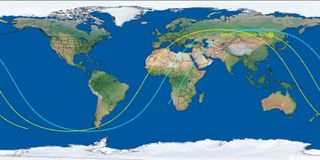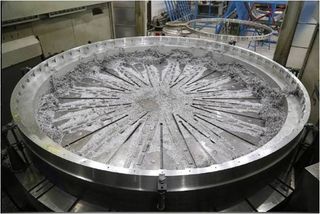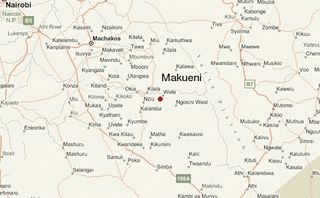Kenya Space Agency (KSA) officials in Nairobia, Kenya, East Africa, are reporting that on Dec. 30 a large metallic ring roughly 8 feet (2.5 meters) in diameter and weighing some 1,100 pounds (500 kilograms) fell from the sky, reportedly “red-hot” and crashed into Mukuku village, in Makueni county – in the country’s south.
Investigators think the object is space debris, believed to be rocket leftovers that came crashing down, reportedly within the village at roughly 3 p.m. local time.
The KSA “secured the area and retrieved the debris, which is now under the Agency’s custody for further investigation.”
However, sky watching veteran and reentry tracker, Jonathan McDowell who works at the Harvard–Smithsonian Center for Astrophysics, told Inside Outer Space that there is “no obvious space candidate. I am not convinced it’s not from an airplane. Don’t see obvious evidence of reentry heating.”
On the other hand, Darren McKnight, a space debris expert at LeoLabs, points out that sometimes incoming space debris stays covered by some “sacrificial mass” that burns up and leaves the raw hardware to reenter.
So what is the object?
Official statement
Following the discovery of a metallic fragment of a space object in Mukuku Village, Makueni County, the Kenya Space Agency has issued the following statement, as posted on X (formerly Twitter):
Following the discovery of a metallic fragment of a space object in Mukuku Village, Makueni County, the Kenya Space Agency has issued the following statement. Read more for details on the incident, preliminary findings, and next steps. pic.twitter.com/n8gsvoKku4January 1, 2025
The agency thanked the residents of Mukuku Village, local leadership, and media outlets for their swift actions in reporting and disseminating the incident.
Possible link?
An early review by Inside Outer Space of the Aerospace Corporation’s Center for Orbital and Reentry Debris Studies (CORDS) Reentry Database suggested a possible link to an incoming rocket body associated with an Atlas Centaur launch back in 2004.
That rocket body leftover, tagged as object 28385, was predicted to reenter on Dec. 30 at 21:33 UTC ± 2 hours, with a flight path taking it over Africa.
The Atlas Centaur rocketed out of Cape Canaveral Space Force Station on Aug. 31, 2004 carrying a classified USA-179 satellite.
According to the NASA Space Science Data Coordination Archive, USA-179 is an American military satellite for the National Reconnaissance Office (NRO), launched by an Atlas 2AS rocket from Cape Canaveral. It was the last flight of the Atlas 2 models.
However, reentry tracker McDowell said U.S. Space Force data showed the 28385 rocket stage reentered over Lake Baikal in Russia.
So yes, further official, KSA assessment of this speculative space debris prospect is likely forthcoming.

In an independent review by Inside Outer Space to better identify the nature of the skyfall, there’s an interesting, but still speculative photo comparison – that could point to some design features of manufactured booster-related hardware and techniques used.

As example, Roscosmos enterprise images of upgraded Angara-A5M rocket hardware seem telling, perhaps, or suggest a type of fabrication process commonly used in the booster-making business by various firms.
Specialists from the Khrunichev Center manufacture parts and components for the first two Angara-A5M launch vehicles, as well as test benches for testing and fine-tuning modern rocket manufacturing technologies.
Use of new technologies in the manufacture of key structural elements with improved weight characteristics relative to the standard Angara-A5 design.
Any follow-up suggestions are welcomed.
Article by:Source























